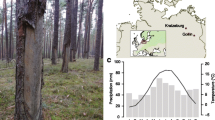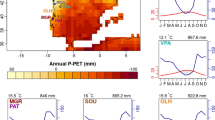Abstract
Pinus pinaster is of great ecological and economic importance and has traditionally been subjected to intensive uses such as wood and resin extraction. In the last decade, dendrochronological methods are increasingly being used to analyze the effects of climatic factors on the growth of the maritime pine, although tapped trees were generally avoided because it was thought that their growth was affected by resin extraction. In Spain, however, it is hard to find a long-lived forest of P. pinaster that has not been subjected to tapping for resin. In the present paper, we performed dendrochronological analyses of this species from wood cores and cross sections taken from both resin-tapped trees and resin-untapped trees killed by a fire in 2008 in the central Iberian region. On the one hand, we reconstructed the history of forest management by means of analysis of resin scars in the cross sections of resin-tapped trees. This facet of dendrochronological dating had not heretofore been developed, and little is therefore known about it. We dated 46 scars, which indicate a history of intensive resin extraction in the 1920–1950 period. Moreover, we attempted to answer the question: Have the old resin extractions in P. pinaster precluded the use of their growth rings for dendrochronological and dendroclimatic studies? We found that resin extraction did not alter general short-wavelength variability, and we developed a local chronology with all synchronized series, and the response function with respect to climate is similar to other oldest P. pinaster forests studied in Spain. The information we have recorded can be of use for providing tools to land managers for interpreting forest dynamics in resin-tapped regions.







Similar content being viewed by others
References
Alcalde C, García-Amorena I, García Álvarez S, García Calvo D, García García R, Génova M, Gil Borrell P, Gómez Manzaneque F, Maldonado J, Morla C, del Nido J, Postigo JM, Regato P, Río S, Roig S, Rubiales JM, Sánchez Hernando LJ (2006) Contribución de la Paleofitogeografía a la interpretación del paisaje vegetal ibérico: estado de conocimientos y nuevas perspectivas de investigación. Inv Agrar-Sist Rec F, Extra 15:40–50
Alía R, Martín S, de Miguel J, Galera R, Agúndez D, Gordo J, Salvador L, Catalán G, Gil L (1996) Las regiones de procedencia de Pinus pinaster Aiton. Ministerio de Medio Ambiente, Madrid
Alía R, Moro J, Denis JB (1997) Performance of Pinus pinaster provenances in Spain: interpretation of the genotype by environment interaction. Can J For Res 27(10):1548–1559
Ballesteros JA, Stoffel M, Bodoque JM, Bollschweiler M, Hitz O, Díez-Herrero A (2010) Changes in wood anatomy in tree rings of Pinus pinaster Ait. following wounding by flash floods. Tree Ring Res 66(2):93–103
Biondi F, Waikul K (2004) Dendroclim 2002: AC ++ program for statistical calibration of climate signals in tree-ring chronologies. Comput Geosci 30:303–311
Bogino S, Bravo F (2008) Growth response of Pinus pinaster Ait. to climatic variables in central Spanish forests. Ann For Sci 65:506–518
Bogino S, Bravo F (2009) Climate and intraannual density fluctuations in Pinus pinaster subsp. mesogeensis in Spanish woodlands. Can J For Res 39:1557–1565
Calama R, Tomé M, Sánchez-González M, Miina J, Spanos K, Palahí M (2010) Modelling non-wood forest products in Europe: a review. For Syst 19(SI):69–85
Caminero L (2009) Estudio dendroecológico de Pinus pinaster Ait. en Moral de Hornuez (Segovia). DEA Project (inedit.)
Candel-Pérez D, Linares JC, Viñegla B, Lucas-Borja ME (2012) Assessing climate–growth relationships under contrasting stands of co-occurring Iberian pines along an altitudinal gradient. For Ecol Manage 274:48–57
Choi YD (2004) Theories for ecological restoration in changing environment: toward ‘‘futuristic’’ restoration. Ecol Res 19:75–81
Choi YD (2007) Restoration ecology to the future: a call for new paradigm. Restor Ecol 15:351–353
Cook ER, Holmes RL (1996) Guide for computer program ARSTAN. In: Grissino-Mayer HD, Holmes R, Fritts HC (eds) The international tree-ring data bank program library version 20 user’s manual. Laboratory of Tree-Ring Research, University of Arizona, Tucson, pp 75–87
Cook E, Kairiukstis L (1990) Methods of dendrochronology. Applications in the environmental sciences. Kluwer Academic Publishers, Dordrecht, p 393
Costa M, Morla C, Sainz Ollero H (eds) (1997) Los bosques ibéricos. Una interpretación geobotánica. Planeta, Barcelona, p 572
De Micco V, Saurer M, Aronne G, Tognetti R, Cherubini P (2007) Variations of wood anatomy and d13C within-tree rings of coastal Pinus pinaster showing intra-annual density fluctuations. IAWA J 28:61–74
De Miguel M, de Maria N, Guevara MA, Diaz L, Sáez-Laguna E, Sánchez-Gómez D, Cervera MT (2012) Annotated genetic linkage maps of Pinus pinaster Ait. from a Central Spain population using microsatellite and gene based markers. BMC Genomics 13(1):527
Díez-Herrero A, Ballesteros JA, Ruiz-Villanueva V, Bodoque J (2012) A review of dendrogeomorphological research applied to flood risk analysis in Spain. Geomorphology 196:211–220
El Khorchani A, Gadbin-Henry C, Bouzid S, Khaldi A (2007) Impact de la sécheresse sur la croissance de trois espèces forestières en Tunisie (Pinus halepensis Mill., Pinus pinea L. et Pinus pinaster Sol.). Sécheresse 18:113–121
Farjon A (2008) A natural history of conifers. Timber Press Inc, Portland
Génova M (2007) El crecimiento de Abies pinsapo y el clima de Grazalema: aportaciones dendroecológicas. Investigacion agraria. Sistemas y Recursos forestales 16(2):145–157
Génova M (2012) Extreme pointer years in tree-ring records of Central Spain as evidence of climatic events and the eruption of the Huaynaputina Volcano (Peru, 1600 AD). Clim Past 8:751–764
Génova M, Caminero L (2009) Effects of the management on tree-ring growth of Pinus pinaster. Abstr Eurodendro 2009:97
Génova M, Moya P (2012) Dendroecological analysis of relict pine forests in the centre of the Iberian Peninsula. Biodivers Conserv 21(11):2949–2965
Gil L (1991) Consideraciones históricas sobre Pinus pinaster Ait. en el paisaje vegetal de la Península Ibérica. Estud Geogr 202:5–27
González-Martínez SC, Mariette S, Ribeiro MM, Burban C, Raffin A, Chambel MR, Ribeiro CAM, Aguiar A, Plomion C, Alía R, Gil L, Vendramin GG, Kremer A (2004) Genetic resources in maritime pine (Pinus pinaster Aiton): molecular and quantitative measures of genetic variation and differentiation among maternal lineages. For Ecol Manage 197(1):103–115
Holmes R (1992a) Users manual for program Cofecha by Laboratory of Tree-Ring Research. University of Arizona, Tucson
Holmes R (1992b) Dendrochronology program library. Installation and program manual. Laboratory of Tree-Ring Research, University of Arizona, Tucson
Holmes R (1999) Program JOLTS: finding growth surges or suppressions in trees. Laboratory of Tree-Ring Research, University of Arizona, Tucson
Jackson ST, Hobbs RJ (2009) Ecological restoration in the light of ecological history. Science 325(5940):567–569
Lageard JGA, Thomas PA, Chambers FM (2000) Using fire scars and growth release in subfossil Scots pine to reconstruct prehistoric fires. Palaeogeogr Palaeoclimatol Palaeoecol 164(1–4):87–99
Lorimer CG, Frelich LE (1989) A methodology for estimating canopy disturbance frequency and intensity in dense temperate forests. Can J For Res 19(5):651–663
McBride JR (1983) Analysis of tree rings and fire scars to establish fire history. Tree Ring Bull 43:51–67
Nanos N, Tadesse W, Montero G, Gil L, Alía R (2000) Modelling resin production distributions for Pinus pinaster Ait using two probability functions. Ann For Sci 57:369–377
Nanos N, Tadesse W, Montero G, Gil L, Alía R (2001) Spatial stochastic modelling of resin yield from pine stands. Can J For Res 31:1140–1147
Rinn F (2003) TSAPWin: time series analysis and presentation for dendrochronology and related applications, version 0.53: user reference. RinnTech, Heidelberg
Rodríguez R, Serrada R, Lucas JA, Alejano MR, del Río M, Torres E, Cantero A (2008) Selvicultura de Pinus pinaster Ait. subsp. mesogeensis Fieschi & Gaussen. In: Serrada R, Montero G, Reque JA (eds) Compendio de Selvicultura Aplicada en España. INIA (Instituto Nacional de Investigaciones Agrarias), Madrid, pp 399–430
Rozas V (2004) A dendroecological reconstruction of age structure and past management in an old-growth pollarded parkland in northern Spain. For Ecol Manage 195:205–219
Rozas V, Lamas S, García-González I (2009) Differential tree-growth responses to local and large-scale climatic variation in two Pinus and two Quercus species in northwest Spain. Ecoscience 16(3):299–310
Rozas V, García-González I, Zas R (2011) Climatic control of intra-annual wood density fluctuations of Pinus pinaster in NW Spain. Trees 25:443–453
Sánchez-Gómez D, Majada J, Alía R, Feito I, Aranda I (2010) Intraspecific variation in growth and allocation patterns in seedlings of Pinus pinaster Ait. submitted to contrasting watering regimes: can water availability explain regional variation? Ann For Sci 67:505
Sánchez-Salguero R, Navarro-Cerrillo RM, Camarero JJ, Fernández-Cancio Á (2010) Drought-induced growth decline of Aleppo and maritime pine forests in south-eastern Spain. For Syst 19(3):458–470
Schweingruber FH (1993) Trees and wood in dendrochronology, Springer series in Wood Science. Springer, Berlin, p 474
Schweingruber FH (1996) Tree-rings and environment: dendroecology. Paul Haupt, Bern
Servicio Territorial de Medio Ambiente y Ordenación del Territorio de Segovia (1992) 4ª Revisión del Proyecto de Ordenación, 1993–2002, Grupo 8° de Ordenación. Consejería de Medio Ambiente y Ordenación del Territorio. Junta de Castilla y León. (inéd.)
Stoffel M, Bollschweiler M, Butler DR, Luckman BH (2010) Tree rings and natural hazards—a state-of-the-art. Springer, Dordrecht
Tadesse W, Nanos N, Auñon FJ, Alfa R, Gil L (2001) Evaluation of high resin yielders of Pinus pinaster AIT. For Genet 8:271–278
Timbal J (2002) Analyse rétrospective de la croissance radiale et mise en relation avec le bilan hydrique dans un dispositif d’intensité d’éclaircie de pin maritime dans les Landes de Gascogne. Ann For Sci 59(2):205–217
Van Horne ML, Fule PZ (2006) Comparing methods of reconstructing fire history using fire scars in a southwestern United States ponderosa pine forest. Can J For Res 36:855–867
Vieira J, Campelo F, Nabais C (2009) Age-dependent responses of tree-ring growth and intra-annual density fluctuations of Pinus pinaster to Mediterranean climate. Trees 23:257–265
Acknowledgments
This research was partially funded by the Senscom (CGL2008-06005), Dendro-Avenidas (CGL2007-62063) and Dinecofor (CGL2011-27229) Research Projects. We wish to thank the Castilla y León Regional Govt. for their help with the sampling, as well as the assistance provided by Eugenio A. Alonso Herbias and Carlos Morla in the preparation and treatment of the cross sections. Andrés Díez made interesting comments that have undoubtedly helped us to transmit the information, and Aitor Gaston helped us with Fig. 1 and E. Sadornil with some statistical analyses. We also thank the comments of the anonymous reviewer. Thanks to all the trees that gave us their history and which no longer exist due to the fire.
Author information
Authors and Affiliations
Corresponding author
Additional information
Communicated by H. Pretzsch.
Appendix
Rights and permissions
About this article
Cite this article
Génova, M., Caminero, L. & Dochao, J. Resin tapping in Pinus pinaster: effects on growth and response function to climate. Eur J Forest Res 133, 323–333 (2014). https://doi.org/10.1007/s10342-013-0764-4
Received:
Accepted:
Published:
Issue Date:
DOI: https://doi.org/10.1007/s10342-013-0764-4




